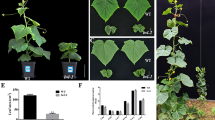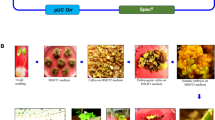Abstract
Granule Bound Starch Synthase I (GBSS I) encoded by the waxy gene plays an important role in accumulating amylose during the development of starch granules in barley. In this study, we isolated and characterized waxy alleles of three waxy (GSHO 908, GSHO 1828 and NA 40) and two non-waxy barley accessions (PI 483237 and CIho 15773), estimated the expression patterns of waxy genes via Real-time quantitative PCR (RT-qPCR), investigated promoter activity by analyzing promoter-GUS expression, and examined possible effects of waxy alleles on starch granule morphology in barley accessions by scanning electron microscopy (SEM). A 193-bp insertion in intron 1, a 15-bp insertion in the coding region, and some single nucleotide polymorphic sites were detected in the waxy barley accessions. In addition, a 397-bp deletion containing the TATA box, transcription starting point, exon 1 and partial intron 1 were also identified in the waxy barley accessions. RT-qPCR analysis showed that waxy accessions had lower waxy expression levels than those of non-waxy accessions. Transient expression assays showed that GUS activity driven by the 1,029-bp promoter of the non-waxy accessions was stronger than that driven by the 822-bp promoter of the waxy accessions. SEM revealed no apparent differences of starch granule morphology between waxy and non-waxy accessions. Our results showed that the 397-bp deletion identified in the waxy barley accessions is likely responsible for the reduction of waxy transcript, leading to lower concentrations of GBSS I protein thus lower amylose content.





Similar content being viewed by others
References
Bhatty R (1993) Nonmalting uses of barley, Barley: Chemistry and Technology. In: MacGregor AW and Bhatty RS (eds), Am. Assoc. Cereal Chem, St. Paul, MN, pp 355–417
Bird AR, Brown IL, Topping DL (2000) Starches, resistant starches, the gut microflora and human health. Curr Issues Intestinal Microbiol 1:25–37
Boscari A, Clement M, Volkov V, Golldack D, Hybiak J, Miller AJ, Amtmann A, Fricke W (2009) Potassium channels in barley: cloning, functional characterization and expression analyses in relation to leaf growth and development. Plant, Cell Environ 32:1761–1777
Cai XL, Wang ZY, Xing YY, Zhang JL, Hong MM (1998) Aberrant splicing of intron 1 leads to the heterogeneous 5′ UTR and decreased expression of waxy gene in rice cultivars of intermediate amylose content. Plant J 14:459–465
Chen PY, Wang CK, Soong SC, To KY (2003) Complete sequence of the binary vector pBI121 and its application in cloning T-DNA insertion from transgenic plants. Mol Breed 11:287–293
Chenna R, Sugawara H, Koike T, Lopez R, Gibson TJ, Higgins DG, Thompson JD (2003) Multiple sequence alignment with the Clustal series of programs. Nucleic Acids Res 31:3497–3500
Denyer K, Johnson P, Zeeman S, Smith AM (2001) The control of amylose synthesis. J Plant Physiol 158:479–487
Domon E, Fuijita M, Ishikawa N (2002a) The insertion/deletion polymorphisms in the waxy gene of barley genetic resources from East Asia. Theor Appl Genet 104:132–138
Domon E, Saito A, Takeda K (2002b) Comparison of the waxy locus sequence from a non-waxy strain and two waxy mutants of spontaneous and artificial origins in barley. Genes Genet Syst 77:351–359
Echt CS, Schwartz D (1981) Evidence for the inclusion of controlling elements within the structural gene at the waxy locus in maize. Genetics 99:275–284
Ezcurra I, Ellerström M, Wycliffe P, Stålberg K, Rask L (1999) Interaction between composite elements in the napA promoter: both the B-box ABA-responsive complex and the RY/G complex are necessary for seed-specific expression. Plant Mol Biol 40:699–709
Fukunaga K, Kawase M, Kato K (2002) Structural variation in the Waxy gene and differentiation in foxtail millet [Setaria italica (L.) P. Beauv.]: implications for multiple origins of the waxy phenotype. Mol Genet Genomics 268:214–222
Higo K, Ugawa Y, Iwamoto M, Korenaga T (1999) Plant cis-acting regulatory DNA elements (PLACE) database: 1999. Nucleic Acids Res 27:297–300
Hunt HV, Denyer K, Packman LC, Jones MK, Howe CJ (2010) Molecular basis of the waxy endosperm starch phenotype in broomcorn millet (Panicum miliaceum). Mol Biol Evol 27:1478–1494
James MG, Denyer K, Myers AM (2003) Starch synthesis in the cereal endosperm. Curr Opin Plant Biol 6:215–222
Jeng TL, Wang CS, Tseng TH, Wu MT, Sung JM (2009) Nucleotide polymorphisms in the waxy gene of NaN3–induced waxy rice mutants. J Cereal Sci 49:112–116
Jiang QT, Liu T, Ma J, Wei YM, Lu ZX, Lan XJ, Dai SF, Zheng YL (2012a) Characterization of barley Prp1 gene and its expression during seed development and under abiotic stress. Genetica 139:1283–1292
Jiang QT, Ma J, Zhao S, Zhao QZ, Lan XJ, Dai SF, Lu ZX, Zheng YL, Wei YM (2012b) Characterization of HMW-GSs and their gene inaction in tetraploid wheat. Genetica 140:325–335
Jobling S (2004) Improving starch for food and industrial applications. Curr Opin Plant Biol 7:210–218
Kluth A, Sprunck S, Becker D, Lörz H, Lütticke S (2002) 5′ deletion of a gbss1 promoter region from wheat leads to changes in tissue and developmental specificities. Plant Mol Biol 49:665–678
Laemmli UK (1970) Cleavage of structural proteins during the assembly of the head of bacteriophage T4. Nature 227:680–685
Lescot M, Déhais P, Thijs G, Marchal K, Moreau Y, Van de Peer Y, Rouzé P, Rombauts S (2002) PlantCARE, a database of plant cis-acting regulatory elements and a portal to tools for in silico analysis of promoter sequences. Nucleic Acids Res 30:325–327
Li J, Vasanthan T, Rossnagel B, Hoover R (2001) Starch from hull-less barley: i. Granule morphology, composition and amylopectin structure. Food Chem 74:395–405
Liu S, Bao Y (2009) Effects of copy number of an octopine synthase enhancer element and its distance from the TATA box on heterologous expression in transgenic tobacco. Acta Physiologiae Plantarum 31:705–710
Liu WX, Liu HL, Chai ZJ, Xu XP, Song YR, Qu LQ (2010) Evaluation of seed storage-protein gene 5′ untranslated regions in enhancing gene expression in transgenic rice seed. Theor Appl Genet 121:1267–1274
Ma J, Jiang QT, Wei YM, Andre L, Lu ZX, Chen GY, Liu YX, Zheng YL (2010) Molecular characterization and comparative analysis of two waxy alleles in barley. Genes Genom 32:513–520
Murray M, Thompson WF (1980) Rapid isolation of high molecular weight plant DNA. Nucleic Acids Res 8:4321–4326
Patron NJ, Smith AM, Fahy BF, Hylton CM, Naldrett MJ, Rossnagel BG, Denyer K (2002) The altered pattern of amylose accumulation in the endosperm of low-amylose barley cultivars is attributable to a single mutant allele of granule-bound starch synthase I with a deletion in the 5′-non-coding region. Plant Physiol 130:190–198
Pfaffl MW (2001) A new mathematical model for relative quantification in real-time RT–PCR. Nucleic Acids Res 29:e45–e45
Radchuk VV, Borisjuk L, Sreenivasulu N, Merx K, Mock HP, Rolletschek H, Wobus U, Weschke W (2009) Spatiotemporal profiling of starch biosynthesis and degradation in the developing barley grain. Plant Physiol 150:190–204
Regina A, Blazek J, Gilbert E, Flanagan BM, Gidley MJ, Cavanagh C, Ral J-P, Larroque O, Bird AR, Li Z, Morell MK (2012) Differential effects of genetically distinct mechanisms of elevating amylose on barley starch characteristics. Carbohydr Polym 89:979–991
Rogers H, Bate N, Combe J, Sullivan J, Sweetman J, Swan C, Lonsdale D, Twell D (2001) Functional analysis of cis-regulatory elements within the promoter of the tobacco late pollen gene g10. Plant Mol Biol 45:577–585
Rohde W, Becker D, Salamini F (1988) Structural analysis of the waxy locus from Hordeum vulgare. Nucleic Acids Res 16:7185
Rösti S, Rudi H, Rudi K, Opsahl-Sorteberg HG, Fahy B, Denyer K (2006) The gene encoding the cytosolic small subunit of ADP-glucose pyrophosphorylase in barley endosperm also encodes the major plastidial small subunit in the leaves. J Exp Bot 57:3619–3626
Rushton PJ, Reinstädler A, Lipka V, Lippok B, Somssich IE (2002) Synthetic plant promoters containing defined regulatory elements provide novel insights into pathogen-and wound-induced signaling. Plant Cell 14:749–762
Sattler SE, Singh J, Haas EJ, Guo L, Sarath G, Pedersen JF (2009) Two distinct waxy alleles impact the granule-bound starch synthase in sorghum. Mol Breeding 24:349–359
Soong R, Ruschoff J, Tabiti K (2000) Detection of colorectal micrometastasis by quantitative RT-PCR of cytokeratin 20 mRNA. Roche Diagnostics internal publication
Swanston J, Ellis R, Stark J (1995) Effects on grain and malting quality of genes altering barley starch composition. J Cereal Sci 22:265–273
Swapna L, Khurana R, Vijaya Kumar S, Tyagi A, Rao K (2011) Pollen-specific expression of Oryza sativa indica pollen allergen gene (OSIPA) promoter in rice and Arabidopsis transgenic systems. Mol Biotechnol 48:49–59
Tang H, Watanabe K, Mitsunaga T (2002) Structure and functionality of large, medium and small granule starches in normal and waxy barley endosperms. Carbohydr Polym 49:217–224
Tester RF, Karkalas J, Qi X (2004) Starch-composition, fine structure and architecture. J Cereal Sci 39:151–165
Van Hung P, Maeda T, Morita N (2006) Waxy and high-amylose wheat starches and flours—characteristics, functionality and application. Trends Food Sci Technol 17:448–456
Vandesompele J, De Preter K, Pattyn F, Poppe B, Van Roy N, De Paepe A, Speleman F (2002) Accurate normalization of real-time quantitative RT-PCR data by geometric averaging of multiple internal control genes. Genome Biol 3:research0034
Weschke W, Panitz R, Gubatz S, Wang Q, Radchuk R, Weber H, Wobus U (2003) The role of invertases and hexose transporters in controlling sugar ratios in maternal and filial tissues of barley caryopses during early development. Plant J 33:395–411
Yanagisawa T, Kiribuchi-Otobe C, Yoshida H (2001) An alanine to threonine change in the Wx-D1 protein reduces GBSS I activity in waxy mutant wheat. Euphytica 121:209–214
Zeeman SC, Kossmann J, Smith AM (2010) Starch: its metabolism, evolution, and biotechnological modification in plants. Annu Rev Plant Biol 61:209–234
Zhu CM (2009) Research on genetic diversity of waxy germplasm resources and wx gene in Chinese barley. Chinese Academy of Agricultural Sciences Publishing, Beijing (in Chinese)
Zhu T, Jackson DS, Wehling RL, Geera B (2008) Comparison of amylose determination methods and the development of a dual wavelength Iodine binding technique 1. Cereal Chem 85:51–58
Acknowledgments
This work was supported by the National Natural Science Foundation of China (31230053, 31000167 and 31171556) and China Transgenic Research Program (2011ZX08002-001,004 and 005) the National Basic Research Program of China (973 Program 2010CB134400).
Author information
Authors and Affiliations
Corresponding author
Additional information
Jian Ma and Qian-Tao Jiang contributed equally to this paper.
Electronic supplementary material
Below is the link to the electronic supplementary material.
Rights and permissions
About this article
Cite this article
Ma, J., Jiang, QT., Zhao, QZ. et al. Characterization and expression analysis of waxy alleles in barley accessions. Genetica 141, 227–238 (2013). https://doi.org/10.1007/s10709-013-9721-x
Received:
Accepted:
Published:
Issue Date:
DOI: https://doi.org/10.1007/s10709-013-9721-x




